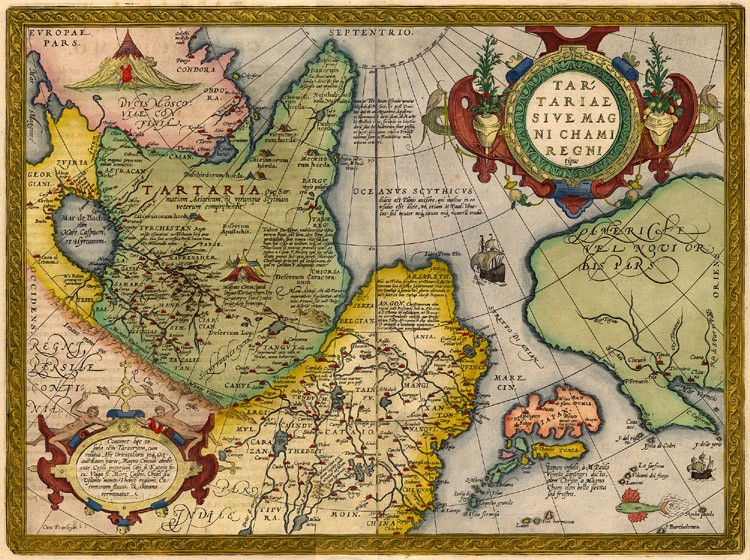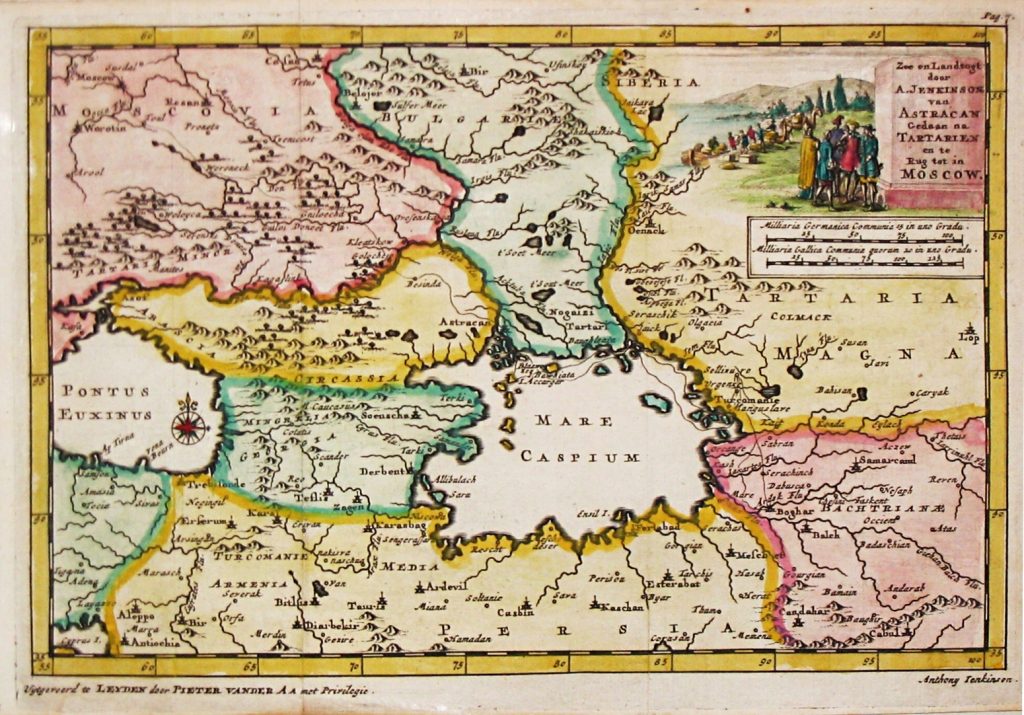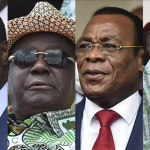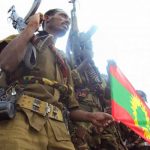The Slavs explored the European part of Russia much earlier than Siberia and the North Caucasus. However, the peoples of Turkic and Mongolian origin, some of whom had a state tradition, were tough enough not to get assimilated but preserve their identity. After the fall of the USSR, nationalist and separatist movements intensified the activity in their territories and strengthened during the period of modern Russia. In particular, we mean the Tatars and Bashkirs, and the Chuvashes and Kalmyks to a lesser extent. The first three peoples refer to Turkic, the last one is Mongolian.
Historical and mental roots. All peoples whose features of mass political consciousness are raised in this material have deep historical roots that explains the current nationalist and separatist tendencies.
Tatars have a tradition of a state that was conquered and subdued by the Kremlin. At the same time this people could not be assimilated despite Moscow’s centuries-old efforts. Since the time of the Russian Empire, Kazan was divided into Russian and Tatar parts, actually, different cities with different religions and different social life style. Unfortunately for the Kremlin it failed to Christianize the Tatars. The tradition of professing Islam turned out to be extremely strong despite the Christianization systematic centuries-old attempts. It is interesting that at present time the Christian Tatars, so-called ‘Kryashens’, stand out as a separate subethnos within the Tatar people. At the same time, they have no significant impact on culture, and researchers say about a low level of their social status in Tatarstan. During the USSR they were assimilated while creating a single ‘Soviet people’, however, the Tatars could preserve their identity. To a great extent it can be explained by the level of social cohesion and the local elite.
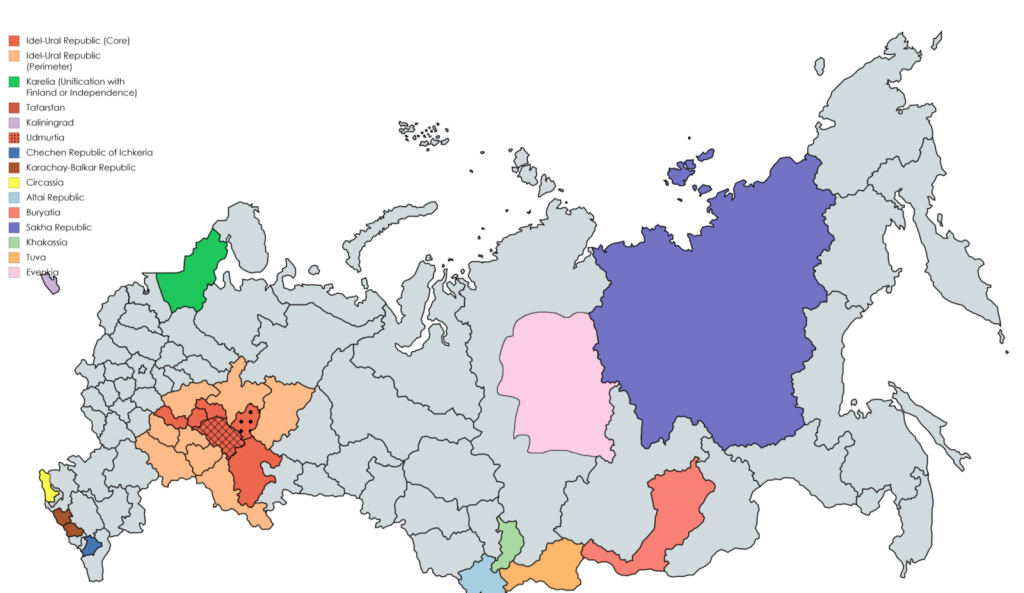
The Bashkirs are a Turkic people who have lived for a long time on the border of the Russian Empire where their representatives were actively involved in military campaigns. The Bashkirs used to make a lot of troubles for the Russian central peoples and rebel. Modern Bashkortostan is significantly limited in its traditional boundaries. Historically, its territory also included the Orenburg and Chelyabinsk regions, in addition to part of Tatarstan, Udmurtia, Sverdlovsk, Samara, Saratov regions and part of the Perm Territory. To a large extent, Bashkortostan’s territory reduction was done artificially in order to prevent from creating its own national state with an external border.
Chuvash people are Turkic people, a rump of the state ‘Great Bulgaria’. Among the three main Turkic peoples inhabiting the European part of Russia, the Chuvash people suffered from assimilation by the Russians the most. However, despite this, ethnic tensions in the region remained until the 19th century; periodically, they rebelled against the Russians. At the beginning of the 20th century, nationalist movements intensified. They were all attempted at connecting the Chuvash people with the ancient Volga Bulgaria, thus establishing the state continuity. This very factor is still important today. In Chuvashia they spread popular historical studies that Moscow calls into question. The studies bring up the search for this ethnic group’s ancient roots.
Kalmyks are the only Mongoloid people living in Europe. The government of Kalmykia considers the republic as the successor of the Dzungar Khanate; it means it supports the cultural and historical line of statehood. Kalmykia is characterized by a high level of the perception of the local population distinctions based on race and religion (Buddhism is widespread in Kalmykia). However, the absence of natural allies among the neighboring ethnic groups in its turn inhibits separatist tendencies. Therefore, as a rule, the nationalists of Kalmykia consider the republic as a part of Russia with more extended rights though.
Geographic features. With no exception, all the Turkic republics, Tatarstan, Bashkortostan, Chuvashia, are enclaves (within the Russian Federation). This is the main reason that curbs separatist tendencies in the region. At the same time, the cross-border regions, historical homelands of these peoples, do not have a lot of Turks. So, Tatarstan can get access to the external border (with Kazakhstan) only if Kazan controls the Orenburg region. Tatars in this region are the second largest ethnic group. However, their proportion in comparison with Russians is insignificant: 7.6% versus 75.9%.
Bashkortostan has the same situation. Bashkortostan lost a part of the border with Kazakhstan in the 30s of the twentieth century (on Stalin’s order, the Kuvandyk region was created to create a buffer between Bashkiria and Kazakhstan). In order to get access to the external border, Ufa needs to control part of the Orenburg region, or part of the Chelyabinsk region. At the same time, the Bashkirs are not a significant ethnic group in the Orenburg region, although they are indigenous people. Their share of the population is 2.3%. It is worth mentioning that the Orenburg Bashkirs are a separate ethnic group who speak the southern dialect of Bashkir. It is noteworthy that the Bashkirs’ communities are concentrated in Orsk, Mednogorsk, Kuvandyk, Novotroitsk and Gai. This is the narrowest part of the Orenburg region between Bashkortostan and Kazakhstan. Thus, for example, Kuvandyk and Gai districts, inhabited by a great part of the Bashkirs, border on Bashkortostan and Kazakhstan. On this territory there is a significant number of metallurgical, oil refining and machine-building enterprises that are economically-promising.
In its turn, Chuvashia is a classic enclave. Therefore, any real separatist movements will appear only following the similar ones in Tatarstan, the frontier state.
Kalmykia has access to the Caspian Sea that gives it the opportunity to establish direct contacts with Kazakhstan, Azerbaijan, Turkmenistan and Iran. At the same time, Kalmykia does not have a seaport yet; the plans to build a port in the city of Lagan have not been implemented. Besides, in the southwest Kalmykia borders on Dagestan, one of the most separatist-minded regions in Russia.
Demographic and cultural trends. The Turkic republics and Kalmykia make no socio-ethnic pressure on the Russian ethnos in contrast to Tuva or Saha. The territorial proximity to the center and a quite high level of socio-economic development of the regions keep the Russian population from departing as in case of Siberia. Yet the number of ethnic Russians is declining. Thus, the population proportion in Tatarstan is Tatars (53%) and Russians (39%). Since 1989, the share of ethnic Tatars has increased by 5%, while the share of ethnic Russians has dropped by 4%. In 13 out of 45 districts and urban districts of the republic Tatars have no majority.
There are three main ethnic groups in Bashkortostan: Russians, Bashkirs and Tatars. Bashkirs are the second largest ethnic group, 29.5% of the population. The share of Russians is 36.1%. The third equal ethnic group in the region is the Tatars, 25.4%. The largest number of ethnic Bashkirs lives in the southeast and north of the republic. Russians live mainly in the northeast and southwest. The Tatars live in the west of the republic. Since 1989, the share of the Russian and Tatar population has been declining (-4% and -4%), while the share of the Bashkir population has been growing (+ 7%).
The predominant ethnic group in Chuvashia is the Chuvash people. Their share in the population in comparison with 1989 has not changed – 68%. At the same time, the number of Russians also remains unchanged, 27%. Russian communities live mainly in the southwest of the republic.
The population of Kalmykia is represented by ethnic Kalmyks (57.4%) and Russians (32.2%). Since 1989, the share of Kalmyks in the republic’s population has increased by 12%, while the share of Russians has fallen by 6%. At the same time, Russian communities historically live in the south-west of the republic.
Tatarstan and Bashkiria are characterized by the most developed cultural and linguistic environment. For example, the surveys show that the Bashkir language is native to 71.7% of the Bashkirs, Tatar is spoken by 14.6%, the Russian language is native to 13.7%. 70% of families with children in Tatarstan chose Tatar as their native language. At the same time, according to surveys, 68% of urban Tatars and 86% of rural Tatars speak, read and write fluently in their native language.
Previously, it was compulsory in Bashkortostan and Tatarstan to teach the languages of the titular nation; these requirements were also set to Russian-speaking students. Following the federal legislation changes, all schools in Russia were standardized to a single federal state education model. It caused repeated scandals in Tatarstan and Bashkortostan regarding the Russian language discrimination in education.
Tatar and Bashkir culture and language environment is the mainstream among youth. At the same time, in Tatar and Bashkir ethnic families the birth rate is significantly higher in contrast to Russian families of the same age. Therefore, for example, since 2001, the share of Tatar city dwellers who speak fluently, read and write in Tatar has increased in the Republic of Tatarstan by 8%.
However, the language in Chuvashia and Kalmykia is endangered. The most families in Kalmykia do not speak Kalmyk even at the everyday level; more than 90% of children speak exclusively Russian. Generally, the level of native language reference among Kalmyks is about 30%. Both the political and the economic elite speak Russian. The Chuvash language, according to the definition of UNESCO, is also classified as endangered. The national culture in both Kalmykia and Chuvashia is not the mainstream among youth and successful citizens. Moreover, if in Chuvashia the number of representatives of the titular ethnic group does not fall, in Kalmykia this number is growing. Thus, to our mind, the issue of the development of the linguistic and cultural environment has no affect on peoples’ exclusiveness self-awareness.
The economic background of separatism. The economic and political elite in Tatarstan and Bashkortostan have a national character. It is mostly due to the high level of economic development and the national elites’ representatives in the key sectors of the economy. Thus, Bashkortostankrom has significant deposits of oil, deposits of brown coal, zinc, lead, cadmium, bauxite, oil shale, copper, gold, iron ores. Bashkortostan ranks first in Russia for oil products and the ninth for oil production. Transport engineering is well developed. The republic produces 53% of isobutyl and butyl alcohols, 100% of baking soda, and 58% of soda ash.
Tatarstan is more developed. The republic produces 6.6% of all-Russian oil, 51.9% of polyethylene, 33.6% of tires, 30.5% of trucks. The key industry is oil production. The unexplored oil reserves are over 1 billion tons. The Romashkinskoye field in Tatarstan is Russia’s second largest. Two other main industries are chemistry and petrochemistry, as well as mechanical engineering. This level of development against the background of a high level of national self-awareness provides the local elite with opportunities to develop the national-cultural environment and try to strengthen its positions in the region.
Economically Kalmykia and Chuvashia are less developed. At the same time, Kalmykia is experiencing a significant outflow of the population because of the socio-economic situation. The local national separatist ideas are spreading by contradiction principle and remind the situation with the regions of Siberia. In particular, there is the following ideologeme: the Kremlin cannot effectively control the territory proving the necessity to give more power to the local elite and to prevent people from other regions of Russia from taking power into their hands. This is the very context the main national unrest is taking place. One of the latest is mass protests against the appointment of Dmitry Trapeznikov, one of leaders of the self-proclaimed Donetsk People’s Republic (eastern Ukraine), as Mayor of Elista. The situation is likely to change after launching a serious economic project under the Kalmyk elite’s thumb. The Lagan seaport building may become such a project.
Creation of a Turkic cluster based on three ethnic groups. The separatist movements in Kalmykia have no national and socio-economic foundation yet. A trigger for a change in the situation can be a change in the situation in the Caucasus and Russia as a whole, or attempts to weaken the Kalmyk elite’s influence in the republic government.
The situation is different in the Turkic republics. The national elites of Tatarstan and Bashkortostan are actually ready to take more power and have all resources for this. At the same time, Chuvashia will follow the decisions made by Kazan and Ufa. However, geographic location and interrelations between peoples prevent the republics from separatist movements. At the beginning of the twentieth century some attempts were made to create a single autonomous region within the framework of Tatarstan and Bashkortostan. We mean here the projects of the State of Idel-Ural, the Cultural-National Autonomy of the Turko-Tatars of Inner Russia and Siberia, the Ural-Volga State, the Tatar-Bashkir Soviet Socialist Republic. However, they have never been effectively implemented.
The today’s reason is not to be sought in the so-called ‘Kuvandyk corridor’ that separates Bashkortostan from Kazakhstan by two districts of the Orenburg region. We are also talking about distinctive features of relations between ethnic groups, mainly, between Tatars and Bashkirs. The nationalists of Bashkortostan believe that Tatarstan has pursued an expansion policy in the Volga-Ural region and stand for more active protection of the Bashkirs’ interests. There are also supporters of the Bashkirization of the Tatars (it is worth reminding that this is one of the three main ethnic groups in Bashkortostan) and opponents of this policy. Since 2018, the concept of the so-called ‘northwestern dialect’ of the Bashkir language has been developed in Bashkortostan. It provides that the native language of the population in the western regions of the Republic of Bashkortostan (mainly inhabited by Tatars) is not Tatar, but Bashkir. This disunity policy is conduct in the interests of the federal center to minimize the possibility for political rapprochement between Tatarstan and Bashkortostan and, thereby, prevent the region from separatism.
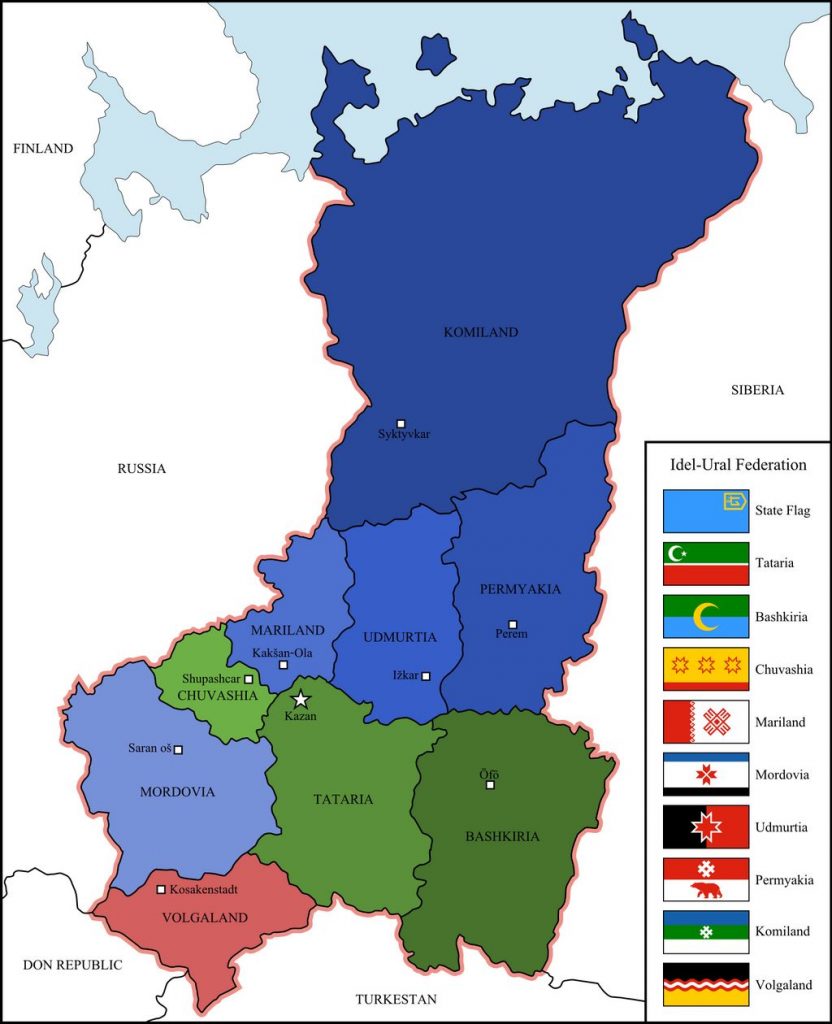
As for Chuvashia, religion plays a key role here. If Sunni Islam is widespread in Tatarstan and Bashkortostan, the majority of the Chuvash are Orthodox Christians. In addition, there is also a negative stereotype among the Chuvash nationalists regarding the Tatars as the dominant ethnic group in the region and the possibility of ‘Tatarization of the Chuvashes’.
As of now, the creation of a model of rapprochement between Tatarstan, Bashkortostan and Chuvashia with an attempt to take control over certain areas bordering on Kazakhstan looks like utopia. However, in case of a significant weakening of the federal center and start of centrifugal processes in the region, this variant of the events should not be ruled out.



